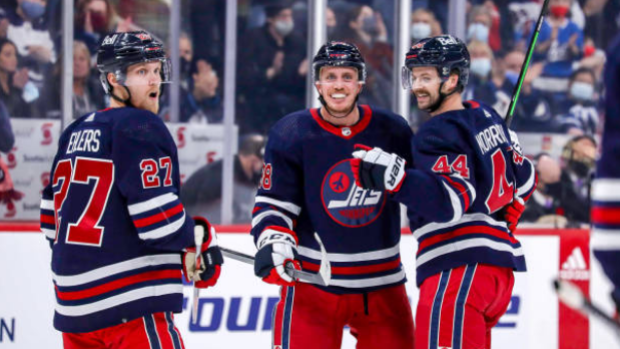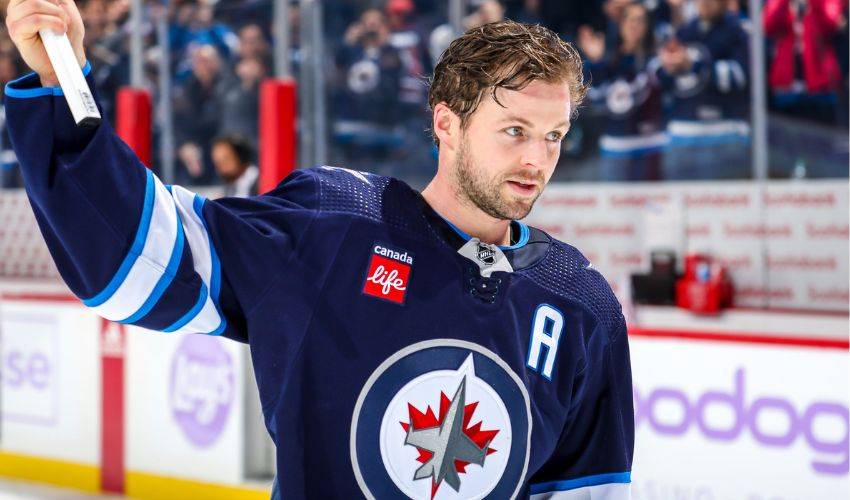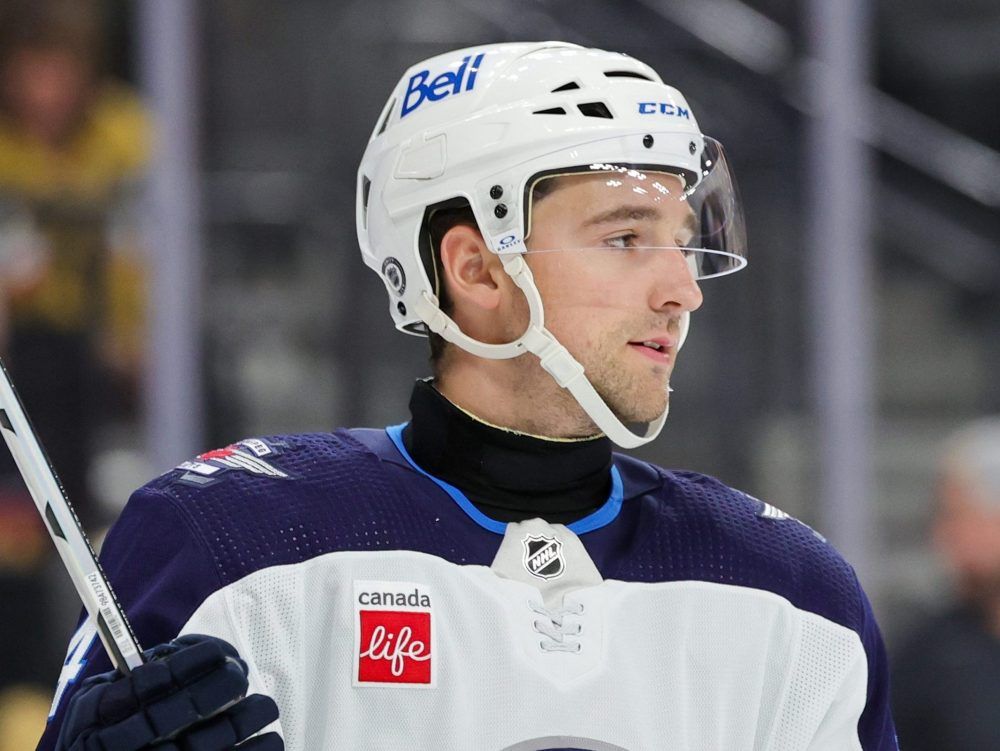
I have Just one world for Jets, My career is finished, Key Star….
Just Give Me The Stats: Jets’ Defensemen
With the news that Craig Berube has agreed to become the new head coach of the Toronto Maple Leafs, the Winnipeg Jets have one less contender to replace Rick Bowness. The amount of media speculation surrounding him signing on with the Leafs made that the likely scenario, but there are plenty of external and internal options still available for Winnipeg. From what I’ve heard, Scott Arniel and Dean Evanson have also interviewed for the position so far and there are other interesting options (Todd Nelson, Rod Brind’Amour, etc).
Besides the coaching search, the True North franchise still has quite a few decisions to be made in the off-season on the defensive side of the puck, so the Jets really need to take a good look at what each player brings to the table. In this article, I am going to dive into the statistics to try and help GM Kevin Cheveldayoff out by showing each defenseman’s strengths and weaknesses.
Due to the larger sample size, I am going to rely on MoneyPuck’s data from the regular season for most of my analysis…although I will also mention their post-season performances a bit when I write a blurb about each player. I also opted to go with 5 on 5 statistics, because that gives us the most even playing field that we can get. Of course, a player on the top pairing like Josh Morrissey would be expected to face stiffer competition when compared to a 3rd pairing guy like Logan Stanley, but this should give us a fairly good idea how well Winnipeg played when each of these defenders were on the ice this season.
Before we get to the graphics below, I thought I would briefly outline what each category represents. The first statistical category is the Corsi, which captures the Jets’ percentage of shot attempts while that player is on the ice. The Fenwick category represents the percentage of unblocked shot attempts, while the xG% is the expected goals percentage. You always want 50% or better with those stats. The next column is the takeaway-giveaway difference (or the T-G DIFF) which obviously tells us if the player coughs up the puck more often than they steal it from the opposing team (positive ratings mean more takeaways). The 5th category is the High Danger Scoring Chances Against per 60 minutes of ice-time, or HDSCA/60, and this tells us how often opponents get great looks on Winnipeg’s goalies when that player is on the ice. The final two columns are similar, with the Goal Differential (GDIFF) showing if the player had more goals for than against and the Expected Goal Differential (xGDIFF) trying to indicate if Winnipeg was expected statistically to score more often when the defender was on the ice.
Due to lack of space, I only included the player’s rank on the Jets for the first three statistic categories in the second table, but have included the range of ratings in the first image to give you an idea how Winnipeg did as a team. Finally, I also sorted the table to represent which pairing each player typically played on this season, starting with the top 2 guys and ending with a bunch of mainly bottom pairing options.
I don’t think a whole lot can be gleaned from the table above, other than it confirming the Winnipeg Jets had a pretty good regular season. In the Corsi, Fenwick, and Expected Goals categories, our squad had 5 or 6 defensemen on the ice for more shot attempts than they allowed….though none of the differences were all that significant. Initially, the Takeaway-Giveaway numbers looked pretty horrific to me, but when comparing it to many other NHL teams, the Jets’ numbers seem to be fairly average. Personally, I am not sure how great the stat takers are at collecting that data, as I have seen a player have a pass intercepted in his own end that resulted in a goal yet the final game stats didn’t show any giveaways for him. The High Danger Scoring Chances Against data appears to be within the range of other strong defensive teams, while the Goal Differential numbers are great for the group. The final category does start to show some chinks in Winnipeg’s armour, as the lower end range dips into the “getting out-played” area.
Since that first graphic didn’t tell us much, lets move onto a more in-depth look at the Jets’ defensive pairing and individual performances with our second table. **stats for Miller include time with NJ
Beginning with a review of the defensive pairings, the shot stats (Corsi/Fenwick) tell us that Winnipeg did a good job edging the puck possession numbers when the 1st and 3rd duos were on the ice, but were on the wrong end of the data when the 2nd pairing was tasked with stopping the opposition. The same goes for the expected goals outlook, with only our middle pairing and Logan Stanley struggling to get above the 50% mark.
Our 4th column looks pretty ugly (and some of it is), but it seems fairly rare for NHL defensemen to finish with more takeaways than giveaways. To illustrate that point, a well-known defensive star like Victor Hedman finished this season with an rating equal to Neal Pionk’s -19. That being said, a franchise like the Vegas Golden Knights had 3 defenders in the positives, while a solid defensive team like the Dallas Stars had no regular d-men out of the minuses. Pretty crazy that Dylan DeMelo could lead the Winnipeg Jets with a +46 plus/minus rating, but still had 40 more giveaways than steals. Barring that outlier, when you look solely at the pairings’ data, it once again shows that the middle group was the only duo to consistently lose the turnover battle by a large margin.
While the range of high danger scoring chances looked good for the group, strong defensive teams like the Dallas Stars or Florida Panthers tended to be closer to the 2.0 rating range, leaving only frequent 3rd pairing partners Dylan Samberg & Nate Schmidt being the only Jets to hit above average levels (in fact, they were likely in the elite range). That being said, Winnipeg’s data was very similar to teams like the Boston Bruins or Tampa Bay Lightning, so they were far from giving up high levels of dangerous scoring looks. For the d-pairings, I was a bit surprised to see that the top pairing was giving up an equal amount of high danger opportunities when compared to the 2nd duo, but otherwise the numbers didn’t shock me at all.
The actual goal differential data for the Winnipeg Jets’ defensemen were all really good…guess it helps a bit when the franchise allowed the lowest number of goals against. However, the 2nd pairing continues to lag behind the other duos and the +36/+37 ratings for Josh Morrissey and Dylan DeMelo is in the elite realm. When switching to the final column, you start to see the benefit of having Connor Hellebuyck & Laurent Brossoit in net, as the drop off from actual to expected is quite large. However, the pattern continues with only the 2nd pairing (and Stanley) consistently losing the xG battle.
Before I move on to look at each individual defenseman on the Winnipeg Jets’ roster I’ll share a couple more things to assist with our review. The first is a graphic from MoneyPuck outlining the actual & expected goal percentages and the second is a table showing how each defender did with various linemates throughout the regular season.
Alright, now that we have a lot of data to look at, we might as well get started analyzing the numbers to see what they tell us.
Josh Morrissey:
Where to start with the Winnipeg Jets’ top defenseman? Probably when he’s at his best…with the puck on his stick. Morrissey had another strong offensive season in 2023-24 and finished with the following accolades: 8th highest scoring defenseman in NHL (69 pts), top 10 in NHL for assists by defensemen per 60 minutes (1.26), all situations (dmen) – 27th in Corsi (57%), 20th in Fenwick (58%), tied with Adam Fox & Quinn Hughes for 8th in actual goal percentage (66.7%), and 15th in expected goal percentage (58.8%).

Defensively, Josh is a sound defender and was the only defenseman on the team with a positive takeaway-giveaway differential, but it’s not like his play in the Jets’ end is without flaws (higher than wanted high danger scoring chances against). Also, he sometimes allows an oncoming forechecker to win the race to the puck, immediately putting Winnipeg on the defensive and killing any chance the Jets had at a clean zone exit. His 6′ frame makes it a bit harder to move opposing forwards from the front of the crease, but Morrissey always ended up winning the expected goals battle with all of his 5 defensive partners this season (the only defender to do that) so his defensive acumen is good enough to go against the NHL’s elite competition.
Overall: Yes, Josh Morrissey is certainly an elite #1 defenseman in the NHL offensively, but the shot/expected goal statistics would put him more in the elite #2 category. That being said, it is possible a slightly better playing partner would improve those stats and make the former 13th overall draft pick even more valuable to the franchise. The 29 yr old is just entering his prime years, so you have to hope that Chevy will be able to help him out by adding to Winnipeg’s blueline in the off-season.
Dylan DeMelo:
The Jets’ top right handed defenseman had a career season, putting up his highest point total (31 pts), a team best from the blueline in goal differential (+37), and the 2nd best plus/minus rating in entire NHL (+46). His steady play in Winnipeg’s end allowed his typical partner (Morrissey) to join the offense, though that -40 takeaway/giveaway rating possibly shows a sign of Dylan having difficulty with clean zone exit decisions.
DeMelo was one of the Jets better defensemen at limiting high danger looks this year despite typically facing the opposition’s toughest tests. He also had positive expected goal numbers with every partner besides the exception of very limited minutes along side Pionk.
Overall: Ideally, Dylan DeMelo would be Winnipeg’s 2nd right-hand defenseman next season, but the likelihood the Jets are able to find a top pairing RHD in the off-season is slim. Therefore, as I previously stated, Chevy definitely needs to get the 31 yr old defender to sign another contract and hope that it doesn’t top the $4.5M per year range, nor have more than 3 years but that may be wishful thinking. Unless the Jets can sign one of the key RHD unrestricted free agents (Brandon Montour or Brett Pesce), the franchise might have to bite the bullet on DeMelo’s ask if they hope to remain competitive in 2024-25.
Brenden Dillon:
The Winnipeg Jets most physical player on their roster this season, the rugged defender easily led the team in penalty minutes (92) but there is a down-side to that. While our franchise had no defenseman with more penalties drawn than taken, Dillon had a team-worst 39 minute differential (Morrissey led the team with a 2 minute differential, while Pionk was a distant second-worst at 20 more PIM taken). Though that is to be expected with the way Brenden plays, as is displayed by the Vancouver Canucks’ Nikita Zadorov’s 52 more penalty minutes taken than drawn rating this season.
Overall, the 33 yr old’s advanced stats were not very good this year….but you have to wonder how much of that is a result of his most frequent playing partner? While the 6’4″ left-hander only played 286 minutes at 5 on 5 with other Jets’ defenders, Dillon’s expected goal ratings were 50% or better with all of them so that very much could be the case. The Canadian defenseman also had a decent high danger scoring chances against rating (tied with DeMelo), despite typically facing top six talent consistently.
Overall: While it certainly sounded like Brenden Dillon wanted to re-sign with Winnipeg, the media reports are painting a picture of that being unlikely. Chevy did say that the team was open to having discussions with the veteran’s agent, so the door for his return isn’t closed but it seems he may be able to reach free agency to at least hear what other options are out there for him. I know many fans are frustrated by the possibility of the Jets letting go one of the few players who knows how to play with the grit needed to succeed in the post-season. I am too, but I also can see that upgrading the 2 LHD spot may be the easiest way to improve the teams’ defense next year. Just as there is a dearth of good right handed defenders, there is typically a bounty of lefties to pick from which makes it easier to acquire one with elite or near-elite skills (i.e. the Sens’ Jakob Chychrun). While a move like that wouldn’t be as impactful as addressing the player I will discuss below, it would certainly up the talent level on Winnipeg’s back end. At this point, salary cap space may be driving Chevy’s strategy with Dillon at this point, however some moves on the draft floor to free up cap space could allow him to circle back before the defender hits unrestricted free agency status on July 1st.
Neal Pionk:
A lightning rod for fan criticism, the 28 yr old Minnesotan put up decent basic statistics with 33 pts, a +9 plus/minus rating, and a +6 actual goal differential this season. However, the advanced stats are a lot more unkind, putting Pionk near the bottom of every category (two last place finishes in xG% & xG Diff, two 7th place finishes in Fenwick & actual G Diff, two 6th place finishes in Corsi & takeaway/giveaway differential, and one 5th place finish in high danger scoring chances allowed).
With his main partner (Dillon) at his side, Neal was able to win the actual goal differential at even strength (52.1%) but the expected goal numbers were below average (46.7%). With four other players beside the right-handed American over the season, only Morrissey (51.1%) and Samberg (58.8%) were able to put up positive xG percentages in 2023-24.

Overall: We all had high hopes for Neal Pionk after he put up 45 pts in 71 games in his first season in the Peg, but his play since then has shown signs of regression. While he only ended with a negative plus/minus rating in one season with Winnipeg (last year), the fact that so many defensemen struggled statistically with Pionk at their side clearly makes him the weakest link on the Jets’ backend. With only 1 yr left on his current deal, the off-season seems like a perfect time to move on and try to find a better solution for the 2nd RHD spot. In my humble opinion, it’s the best route for the Jets to improve but it may be difficult to nab the right player via free agency or trade. One can dream though…the team might as well try something as I am not sure Pionk is best suited for 2nd pairing minutes.
Dylan Samberg:
With mainly sheltered 3rd pairing minutes over the season, the 25 yr old defenseman finished in the top three in 5 out of 7 of the advanced stats in the 2nd chart (5th in xG% and xG Diff). Samberg doubled his previous career-high point total (18), but he will never be much of an offensive threat so has to make the most of his defensive & penalty killing skills. The American was tied for 3rd in blocked shots on the Jets this season (111), despite playing 6 minutes less per game than the leader (DeMelo’s 139). The former 2nd rounder took more penalties than he drew, but his number was equal to Stanley’s despite playing 874 more minutes.
Samberg ended up with 60%+ of actual goals at 5 on 5 for Winnipeg and the final table shows us that he played well with 5 out of 7 partners in the regular season. He had troubles playing on his off-hand when paired with Big Stan (39.8% xG) and never found his game with newly acquired Colin Miller in the handful of games they were a pair (41.4% xG). My biggest complaint about Sammie’s game this season was the lack of physical play and that is a feeling the stats have supported since he had 26 less hits when compared to last year, despite playing 15 more games in the past season. Not sure if the 6’3″ lefty was banged up or not, but he has to use his big frame better to intimidate opposing players.
Overall: I still have hopes that Dylan Samberg can be a solid #2 LHD at the NHL level if he is paired with the right partner, even though he did struggle quite a bit in the playoffs this year. Heck, he had the best xG% when paired with the apparent anchor Pionk during the regular season (58.8% in 151 mins), so imagine what he could do with Pesce or Montour? I mentioned the need to up his physical game previously and that will be doubly important if Dillon is not retained. There is no doubt that Samberg can function as an above average 3rd pairing guy, but I’m sure the team is hoping he can take a bigger step in the upcoming season.
Nate Schmidt:
I will admit that the 32 yr old’s advanced stats surprised me a bit when I finally finished tabulating everything. I do recall that early on in the season, the pairing with Samberg was extremely efficient at out-scoring opponents but even so to see that Schmidt had positive xG numbers with 5 out of 6 partners caught me off-guard. Nate finished with the best Fenwick, best xG%, and the least number of high danger scoring chances against per 60 mins (1.60).
Despite the good possession numbers, the offense wasn’t there for the American defender this year as he put up his 2nd lowest point total of his career (14). Another negative about the lefty who plays the right side is the fact that he is not really an option on the penalty kill for Winnipeg, putting extra strain on the top two pairings’ stamina limits and that is not really ideal.

Overall: If it wasn’t for his $5.95M per year salary, Nate Schmidt might be a pretty solid 3rd pairing option, especially when you consider his ability to play both sides of the ice. His ability to put up solid xG% numbers with both Samberg & Stanley is valuable, but not irreplaceable. The same can be said for his positive attitude on the bench & in the dressing room, because the tight cap space situation Chevy faces this summer may make keeping a highly paid bottom pairing guy too costly for the Jets to consider.
Colin Miller:
There wasn’t much data available for Miller with the Winnipeg Jets, so I had to use his New Jersey Devils’ stats for some of the tables. When you look at how he performed overall this season, the 31 yr old defenseman ends up near the top of the team in a lot of categories. However, when you focus on how he did with a Jets’ jersey on his back, the numbers are down-right ugly (less than 50% xG with both Samberg & Stanley). His 12.5 xG% in 12.5 minutes playing with Big Stan was particularly horrific, but only getting into a handful of regular season games didn’t allow the right hander to gain any familiarity with his teammates.
Things changed in his one post-season game however, as the 6’1″ RHD didn’t allow a high or medium danger shot attempt against while playing on the 3rd pairing, drew an Avalanche penalty, picked up an assist, and had 4 hits in the game (tied for highest per game average with Dillon & DeMelo).
Overall: I have no idea if Colin Miller would be open to re-signing in the Peg and am totally on the fence about whether Chevy should even try. The defender doesn’t appear to really be a full-time NHLer, as he has only played more than 60 games in 4 of his 9 NHL seasons (1 in past 5 years). He definitely has potential as a depth defender who may be able to up his game come playoff time, but once again salary cap space may prevent Winnipeg from winning his services (even if he should only cost around $1.8-$2M/yr).
Logan Stanley:
And we end things with the 6’7″ giant, who is in his 4th NHL season with the Winnipeg Jets since being drafted 18th overall in 2016. Stanley was far from a regular this season (25 games), but did manage to suit up a bit more often than last season (19). The large lefty’s advanced stats are not very good, with Logan not finishing higher than 6th in any of the 2nd table’s seven categories. While the 25 yr old ended up being on the ice for 59.1% of goals scored at even strength, his expected numbers were much lower (2nd worst on the team at 47.9%).
With 45 hits in 25 games, Big Stan wasn’t in the realm of Winnipeg’s most frequent hitters (Dillon’s 241/Pionk’s 221), but he did use the body as consistently as players like DeMelo & Miller did this season. Stanley did end up with more PIMs this season (36 from 21 mins), but he also did a much better job at drawing penalties (22 from 9 mins). Another positive about the Ontario native is his ability to put the puck on the net, as his average of approximately 3 shots per game is good for a 3rd pairing player. That number was hindered a bit by 24 blocked shot attempts, which was a pity since Logan seemed to create more rebounds with his shots than expected.

Overall: Still a restricted free agent for one more season, Chevy doesn’t really have to make a huge decision on Logan Stanley this summer. Offer him a qualifying offer and you are pretty much guaranteed to get a depth defenseman at a cost around $1.1 to $1.2M for one season. The GM can still move him later in the off-season if the opportunity arises or completely bury his salary in the minors if he doesn’t crack Winnipeg’s top 7 defenders in 2024-25. But an argument could definitely be made that there hasn’t been enough signs that Stanley is “getting it” and it’s time to move on from one of the Jets’ rare whiffs in the 1st round of drafts.
Well, that is the end of a very long review of the Winnipeg Jets’ defensive outlook. Did any of the data change your mind about who needs to stay and who needs to be shown the door?
Personally, my opinion is that the BEST option to improve the defense is to find a serious upgrade for Pionk in the 2RD slot, but that may prove difficult for a franchise from a small market, high-tax area, and with a small amount of cap space to play with. Should that fail, then possibly Chevy reverts to trying to upgrade the 2LD spot (over Dillon) while possibly improving the 3RD slot (over Schmidt). A lot will depend on if the Winnipeg Jets are active on the trade front at the draft, as there is always the possibility of taking advantage of one of Cheveldayoff’s fellow GMs. With only two definite “keepers” signed (Morrissey/Samberg), the front office certainly has plenty of work to do to keep the fans happy.
Leave a Reply